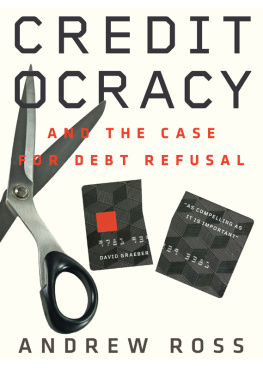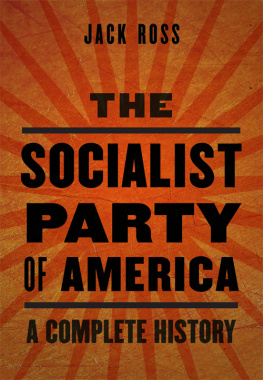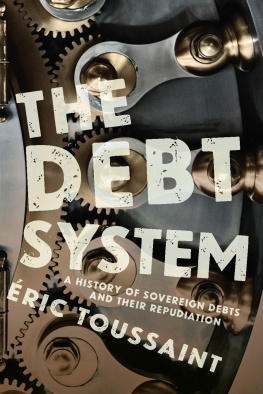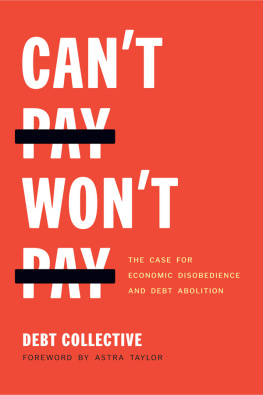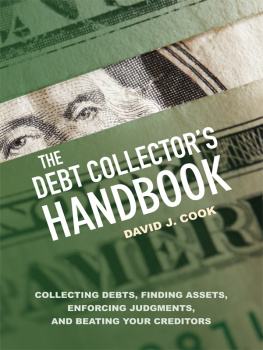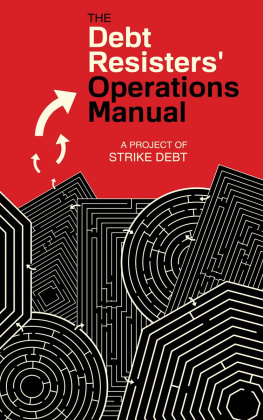


2013 Andrew Ross
Published by OR Books, New York and London
Visit our website at www.orbooks.com
First printing 2013
All rights reserved. No part of this book may be reproduced or transmitted in any form or by any means, electronic or mechanical, including photocopy, recording, or any information storage retrieval system, without permission in writing from the publisher, except brief passages for review purposes.
Cataloging-in-Publication data is available from the Library of Congress.
A catalog record for this book is available from the British Library.
ISBN 978-1-939293-38-1 paperback
ISBN 978-1-939293-39-8 e-book
Text design by Bathcat Ltd. Typeset by Lapiz Digital, Chennai, India.


ACKNOWLEDGMENTS
Many fellow activists in the debt resistance movement contributed ideas, arguments, inspiration, and community love to this book. They include George Caffentzis, Chris Casuccio, Ann Larson, Pam Brown, Astra Taylor, Laura Hanna, Yates McKee, David Graeber, Aaron Bornstein, Thomas Gokey, Suzanne Collado, Sue Meaney, Amin Husain, Nitasha Dhillon, Nick Mirzeoff, Marisa Holmes, Chris Brown, Aleksandra Perisic, Sarah McDaniel, Matt Presto, Andrew Hiller, Christina Daniel, Shyam Khanna, Jacques Laroche, Hilary Goodfriend, Brian Kalbrenner, Nicole Hala, Luke Herrine, Christine Nyland, Sean McAlpin, Cristian Mejia, Sandy Nurse, Jerry Goralnick, Jim Constanzo, Mike Andrews, Steven Tran-Creque, Max Cohen, Ryan Hickey, Robert Oxford, Doug Barrett, Nick Katevich, Mike Monicelli, Sara Burke, Justin Wedes, Monica Johnson, Hannah Appel, Biola Jeje, Matthew Tinker, Rene Gabri, Ayreen Anastas, Bill Talen, Jacques Servin, Sylvia Federici, Ashley Dawson, Marina Sitrin, Nathan Schneider, Austin Guest, Mark Read, Malav Kanuga, Morgan Buck, Conor Tomas Reed, Zak Greene, Ingrid Burrington, Leina Bocar, Chris Kasper, Annie Spencer, Nina Mehta, Kylie Benton-Connell, Zoltan Gluck, Michele Hardesty, Isham Christie, Christy Thornton, Stuart Schrader, Daniel Cohen, and fellow jailbirds, Laurel Ptak and Matthew Connors.
Writers who have been fellow travelers on the killing fields of debt include Sarah Jaffe, Mike Konczal, Cryn Johannsen, Alan Collinge, Steve Fraser, Richard Dienst, Michael Hardt, Chris Newfield, Tamara Draut, Samir Sonti, Adolph Reed, Jeff Williams, Fred Moten, Anya Kamenetz, Nick Pinto, Seth Ackerman, Pam Martens, and Rachel Signer.
Many thanks to NYU comrades from the FASP core, who include Marie Monaco, Mark Miller, Rebecca Karl, Molly Nolan, Bertell Ollman, Christine Harrington, Adam Becker, Jeff Goodwin, Jim Uleman, Angela Zito, Patrick Deer, Bo Riccobono, Denis Geronimus, Anna McCarthy, Robby Cohen, Steve Duncombe, Barbara Weinstein, Michael Reckenwald, Ernest Davis, Danielle Holke, and Linda Gross,
It was a great pleasure to work again with my editor and friend Colin Robinson (YNWA), and with John Oakes. Natasha Lewis, Emily Freyer, Justin Humphries and Courtney Andujar were a superb team at OR Books. Im also grateful to Jackson Smith for his assistance with preparing the manuscript.
On the home front, Maggie was a nonstop affirmer, even when she feigned being an Occupy widow. And all hail to Zola and Stella for stepping up to be the original Little Red Squares.

INTRODUCTION
From April to June 2013, U.S. banks recorded their highest-ever profits for a quarter$42.2 billion. Even those who routinely cheer every report of higher earnings had reason to pause. Maybe this was one piece of upside financial news that should not be ballyhooed. For one thing, the lions share of the profits went to just six banks (Bank of America, Citigroup, Wells Fargo, JPMorgan Chase, Goldman Sachs, and Morgan Stanley), all of them larger and more powerful than they were before their institutional greed helped to decimate the global economy in 2008. Five years after the financial collapse, their capacity to operate beyond the reach of regulators was even more apparent. On March 6, 2013, U.S. Attorney General Eric Holder confessed to the Senate Judiciary Committee that when banks acquire so much concentrated power, it is difficult for us to prosecute them if you do bring a criminal charge, it will have a negative impact on the national economy, perhaps even the global economy. Was it refreshing or just plain alarming to hear the nations top law enforcement official frankly acknowledge how helpless he was in the face of the too big to fail (now seen as too-big-to-jail) doctrine that had served the bankers so well even as it caused a worldwide depression?
Using international accounting rules, the combined assets of the big six totaled $14.7 trillion (or 93 percent of U.S. GDP in 2012), while the entirety of the countrys banking assets was worth 170 percent of GDP. In Europe, the situation was even more acute; Germanys banking sector, for example, clocked in at 326 percent of national GDP, while the go-go U.K. banks were at 492 percent. The exposure of American banks to derivatives alone had increased to $232 trillion, almost a third more than before 2008 when the escalation of these risky bets helped to bring on the financial crash. Those figures are much more telling than the ratio of overall national debt to GDP, though the latter has commanded all the attention, and has been cynically and unjustifiably seized on by deficit hawks as an excuse to crank up the engines of austerity. Just as chilling was the news that the big six U.S. banks collectively were carrying a debt load of $8.7 trillion. With that combination of debt overhead, exposure to dodgy derivatives, leverage over the national economy, and continued weak regulatory oversight, there is a very high risk of a repeat of the 2008 meltdown. Indeed, many industry insiders believe that an equally ruinous relapse is already in the making.
Holders admission that the government lacked the wherewithal to punish bankers for their widely publicized record of extortion was a significant milestone, particularly for a democracy that has long struggled to contain the damage inflicted by plutocrats in its midst. The ability of Wall Street barons to hold the government in thrall is nothing new. Owning lawmakers may be a venerable prerogative for American financiers, but the rise of a full-blown creditocracy is more recent. Financialization had to creep into every corner of the household economy before the authority of the creditor class took on a sovereign, unassailable character.
In other words, it is not enough for every social good to be turned into a transactional commodity, as is the case in a rampant market civilization. A creditocracy emerges when the cost of each of these goods, no matter how staple, has to be debt-financed, and when indebtedness becomes the precondition not just for material improvements in the quality of life, but for the basic requirements of life. Financiers seek to wrap debt around every possible asset and income stream, ensuring a flow of interest from each. Furthermore, when fresh sources of credit are routinely needed to service existing debt (neatly captured in the 1990s bumper sticker, I Use MasterCard to Pay Visa), As for the beneficiaries, the tipping point for a creditocracy occurs when economic rents from debt-leveraging, capital gains, manipulation of paper claims through derivatives, and other forms of financial engineering are no longer merely a supplementary source of income, but have become the most reliable and effective instrument for the amassing of wealth and influence.
Next page
